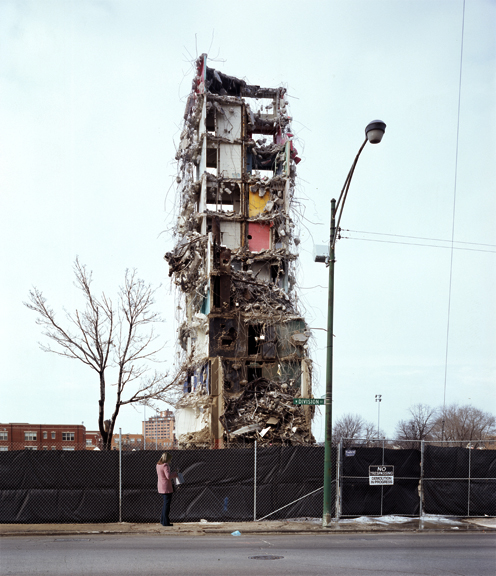 [Image: The old tower blocks of Chicago’s Cabrini-Green, transformed by demolition into totem pole-like wind instruments, flute-ruins, a musically-active wasteland whistling to itself behind security fences. Photographer unknown; spotted at Archinect. It seems worth briefly pointing out, however, that Cabrini-Green could instead have been architecturally salvaged and later reused—and, given a different economic model, the towers could also have been refurbished. Indeed, through that latter link we learn that the combined weight of London’s existing tower blocks is an astonishing forty million tons—meaning that high-rise building materials constitute a near-geological presence in many cities, and they should not simply go to waste…].
[Image: The old tower blocks of Chicago’s Cabrini-Green, transformed by demolition into totem pole-like wind instruments, flute-ruins, a musically-active wasteland whistling to itself behind security fences. Photographer unknown; spotted at Archinect. It seems worth briefly pointing out, however, that Cabrini-Green could instead have been architecturally salvaged and later reused—and, given a different economic model, the towers could also have been refurbished. Indeed, through that latter link we learn that the combined weight of London’s existing tower blocks is an astonishing forty million tons—meaning that high-rise building materials constitute a near-geological presence in many cities, and they should not simply go to waste…].
Would this be an example of Albert Speer’s ruin value concept? Or does the building need to fall on on its own?
These photos are of the Adam’s Mark Hotel demolition this past summer in Phila. Not as loaded with cultural implications as Cabrini-Green but interesting anyway….
http://www.flickr.com/photos/werdsnave/181269088/in/set-72157594186554845/
http://www.flickr.com/photos/werdsnave/177241926/in/set-72157594180746764/
Wow, Andrew – amazing first shot. Amazing second shot, too. Was that down near the airport? I don’t remember that demolition.
Excellent point, Geoff, that the building c/should have been salvaged. Thanks for the mention and the related links. Actually do you know of more: mass-reuse of materials? Anyone else, out there, have any such interesting related links?
Urban Renewal … as a new industry in/of itself (not just individual isolated projects) is the focus of my research/design work. This is should/must and will be the next major industry, I believe. Think about it: in an urbanized society, cities are where the many eco/social problems … and their solutions are to be found. Truly enormous potential. Something people don’t foresee in the same sense as in the years just before the introduction of the automobile (and it’s mass acceptance). Think about how the world can ‘be’ changed for the better … by design!
Thanks,
David.
Architect John Ronan once proposed turning Chicago’s old main post office into a cemetery. It’s quite brilliant in that a monolithic concrete structure may have a greater positive environmental impact than, say, an entire field of green roofs in the Loop. Well, actually, I can’t scientifically validate that last statement, but it’s what I suspect. And if one consider that cemeteries are a multi-billion dollar industry, I’d say it’s quite an innovative strategy for urban renewal.
In Vietnam partially deconstructed buildings – usually due to road widening – are left semi-intact and occupied – a sort of cross-section through life.
See http://www.teeandcee.com/and/archives/69 for a single example, but there are entire highways of partially demolished houses still occupied.
The resonance of Cabrini goes beyond this lovely photograph. When I worked there for a social services agency in the early 1990’s, I was amazined to find that the very logo of the Chicago Housing Authority (CHA, see top image in:
http://www.la.wayne.edu/polisci/kdk/stuff/cha_v_corbusier.pdf
) directly included an image of towerblocks and highways that would have delighted Le Corbusier (see
http://drwagnernet.com/40b/lecture-view.cfm?lecture=9&image=114
) or his contemporaries and actually looks a lot like the subteranean workers’ city in Metropolis (see:
http://www.watson.org/~mccann/Metropolis/Workers/Bell.JPG).
It is notable that the CHA has now moved to a very different logo (see
http://www.chicagoparkdistrict.com/images/logo_affiliate_chicagohousingauthority.gif
) with much smaller-scale buildings, trees, and lots of small fractural elements designed, I think, to express liveliness rather than monumentality, a major swing to the Jane Jacobs end of the spectrum.
I will be curious to see if the pendulum ever swings back around to massive, orderly and rectilinear. I was about 11 when I first saw Robert Hughes’ Shock of the New on PBS and was transfixed by the amazing city drawings that filled the screen (Hilbersheimer’s among others, see the bottom frame of:
http://www.la.wayne.edu/polisci/kdk/stuff/cha_v_corbusier.pdf
). For a lego fanatic, /that/ was how a city was /supposed/ to look. It took me a long time to realize that Hughes was not a fan of the plans he was showing on the screen and to come around to his opinion, but can the inner 11-year-old lego urban planner always remain suppressed?
kevin your post makes me think of the micheal wolf photss of hong kong that i saw on Magic Urbanism (http://www.magicalurbanism.com/?p=127) i imagine that at some point population densities will eventually push chicago to that extreme too and in 50 years we can come back and update this thread with CHA’s newest logo
Would anyone have a recording of this? We’d love to see if we can use it in our music ~ Ed (themechanic@bombergirl.us)
sort of as a follow up to ed, does anyone know the address of this? i dont really want to go wandering around caprini green with a recording device with out knowing where i’m headed
nigel – no idea. I’m not even sure the ruins are still standing, but if you drive around a bit I’m sure you’ll see them or something similar. I wouldn’t be too nervous about walking around, either – but that’s just me.
If a recording works out as planned, let me know!